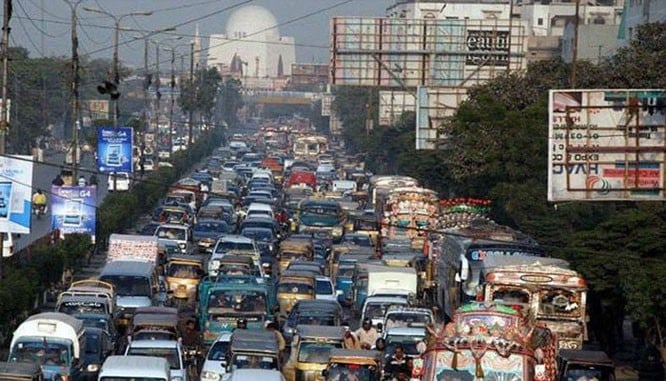
Efficient town planning is imperative to cope with increasing traffic in cities

Lahore and Karachi have populations that run into tens of millions. These cities are faced with the worst form of traffic congestion. This problem is ballooning up despite spending billions of rupees on projects aimed at facilitating the traffic flow. Traffic congestion takes the ugliest form during the peak rush hours in the morning, afternoon and evening when children and people go to their schools/work and get back home. Furthermore, emission of gasses from vehicular traffic poses serious hazard to health and our environment.
There are many contributing factors to this situation: migration from rural areas to urban cities, increase in population growth, lack of efficient public transport system, encroachments, violation of traffic laws, protests and wrong parking are some of them. A large number of people migrating to urban centers puts extra pressure on the already overburdened transport and socio-economic infrastructures of the cities. With population in cities expanding, it will remain a serious threat for policy makers to deal with this problem.
This is an area where efficient town planning comes into play. There must be an upper limit of population for different cities keeping in view their resources, space and limitations.
Lack of proper and adequate urban transport system is forcing people to arrange for personal transport which results in an extraordinary burden on roads disturbing the flow of traffic. Absence of affordable mass transport creates a vacuum which is filled by ride-hailing companies like Careem, Uber and qingqi rickshaws. Though these rickshaws are dangerous, it is the most popular mode of transport not only among the rural people but people living in the cities as well. There is no adequate data of total number of registered and unregistered qingqi rickshaws in the country.
We must learn from advanced countries where car-based mobility is discouraged and shared mobility culture is encouraged. It is worth mentioning here that it does not need money to deal with every problem like observance of traffic discipline. For example, children in elite schools use cars-with-drivers that virtually choke the traffic on the different arteries of the city in the morning and afternoon. The worst part of this arrangement is that drivers park cars on service lanes or residential areas obstructing the flow of traffic.
Can’t these elite schools, which are reaping huge profit, introduce a comprehensive transportation system for their students? A coaster bus can accommodate thirty students in a comfortable environment and plying these buses on roads instead of cars will provide relief to traffic problems. Another point is that these schools which claim to believe in critical thinking and modern outlook appear to be free from civic responsibility. They have turned themselves into corporate institutions taking least care of the traffic mess they are creating.
Another strategy may be to introduce different timetables for different schools with thirty to forty minute’s gap so that roads may not witness a mess of traffic jam at a particular point in time. This is quite a doable step and just need proper planning.
Encroachments also clog roads. Service lane is usually used for parking. There are thousands of plazas on busy roads which are constructed without appropriate parking place. All commercial buildings which are constructed without proper parking space must be razed to the ground. Similarly, heavy fines must be imposed on vehicles wrongly parked alongside main roads. Heavy traffic like containers, trucks and tankers must be banned during the day hours.
Traffic awareness among people about traffic laws is a basic step toward solving this problem. While designing or expanding transport infrastructure our policy makers must also keep in view the needs of pedestrians. Our urban road network falls short of meeting the needs of growing population, but the situation can be improved provided public transport system is in place, traffic laws are strictly implemented and some necessary corrective actions are taken.